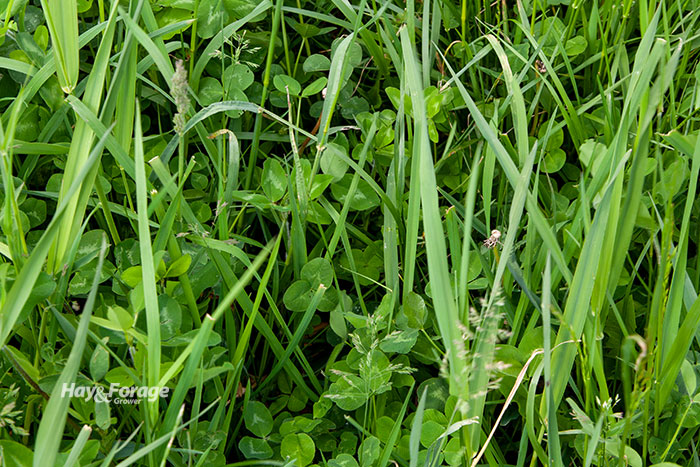
Legume species — specifically clovers — wear many hats during their forage role. They improve forage quality and quantity in a mixed stand, form symbiotic relationships with bacteria that fix nitrogen in the soil, and red clover can help combat tall fescue toxicosis in livestock.
Despite these merits, clover tends to thin in pastures over time and must be reseeded every three to four years. Farmers can implement reduced tillage, no-till seeding, or frost seeding; however, Chris Teutsch, Ray Smith, and Jimmy Henning with the University of Kentucky Extension suggest frost seeding is the simplest reseeding strategy that requires the least amount of time and equipment.
“Frost seeding is accomplished by broadcasting clover seed onto existing pastures or hayfields in late winter and allowing freezing and thawing cycles to incorporate seed into the soil,” the forage specialists explain.
Frost seeding is best suited for red and white clover, as well as annual lespedeza. The specialists recommend frost seeding clover in February or early March, and they share the following tips for successful establishment.
1. Test soil and adjust soil fertility. Before frost seeding, make sure soil fertility is conducive to clover requirements. Take samples and test soil to determine if lime or fertilization is necessary to bolster crop growth. Annual lespedeza is more tolerant of soils low in fertility but generally only persists for one year.
2. Control broadleaf weeds. “Ideally, broadleaf weeds should be controlled prior to seeding legumes since most herbicides will damage clover seedlings,” the specialists note. “This is best accomplished by controlling weeds the season prior to renovation.”
3. Suppress sod and reduce residue. Suppressing sod and getting rid of excess plant material on the soil surface will enhance the effect of freezing and thawing cycles for frost seeding. The specialists suggest the best way to do so is via heavy grazing the previous fall and early winter.
4. Use high-quality seed varieties. Select clover seed that has been tested in similar growing conditions and that has performed above average in forage research trials for multiple site-years. Use certified or proprietary seed to guarantee sufficient germination, desirable seed genetics, and low noxious weed content. Do not use common seed or variety not stated (VNS) seed.
5. Inoculate seed. “Most improved clover seed comes with a lime-based seed coating that contains inoculant,” the specialists state. “If the seed is not pre-inoculated, inoculate it with the proper strain of nitrogen-fixing bacteria prior to seeding. This is relatively inexpensive insurance that optimum nitrogen fixation will take place.”
6. Use an appropriate seeding rate. “Make sure to maintain and calibrate broadcast seeding equipment prior to planting,” the specialists advise. “Seeding at too high of a rate needlessly results in higher seed costs. On the other hand, seeding at too low of a rate results in weak stands and lower productivity.”
7. Monitor seeding distribution. Keep an eye on seeding pattern during planting to prevent clover from growing in strips rather than uniformly. The specialists point out single disc spinners can unevenly distribute seed to one side of the machine if it is not adjusted correctly. They also recommend using a global positioning system (GPS) to maintain a consistent distance between passes, avoid misses and overlaps, and regulate equipment speed.
8. Ensure good seed-to-soil contact. Although frost seeding depends on freezing and thawing cycles to initiate germination, producers can enhance seed incorporation in the soil by dragging pastures as it is being broadcasted. The specialists note rolling a field with a corrugated roller after seeding can benefit frost seeding as well.
9. Control competition. Competition is one of the biggest culprits for frost seeding failure. Therefore, allow livestock to occupy pastures where clover seed has been broadcasted until the plants are tall enough for animals to graze them. Then, remove livestock from the field until the clover is 6 to 8 inches tall. This is when the paddock can be put back into the grazing rotation.

Amber Friedrichsen served as the 2021 and 2022 Hay & Forage Grower summer editorial intern. She currently attends Iowa State University where she is majoring in agricultural communications and agronomy.

